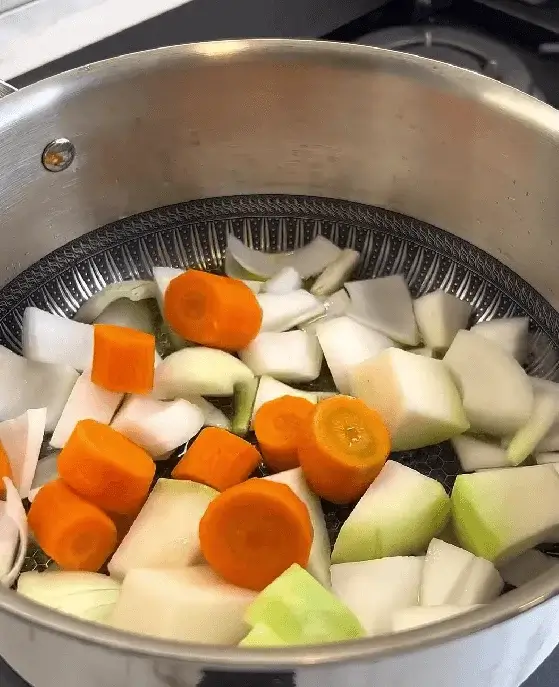Nature’s Penicillin: Authentic Jewish Chicken Soup
We may earn a commission from recommended products, at no extra cost to you. See Disclosure.
INGREDIENTS
Soup:
- 4 chicken drumsticks
- 1 leek, cubed
- 2 onions, cubed
- 2 carrots, cubed
- 1 kohlrabi, cubed
- 4 celery stalks including leaves, cubed
- Bouquet garni: A bunch of thyme, parsley, and dill tied together
- 1 teaspoon turmeric
- ½ teaspoon black pepper
- 1 tablespoon salt
- 3 tablespoons olive oil
- 3 liters boiling water
- A handful of parsley, chopped (optional)
Pasta:
- 2 cups thin egg noodles
- Boiling water to cover
- 1 teaspoon salt
- 2 tablespoons oil
INSTRUCTIONS
Soup:
- In a deep pot, sauté the onions, chicken, and vegetables in olive oil. Add water, spices, and the bouquet garni. Bring to a boil and simmer for 10 minutes, then reduce heat and cover for an hour and 15 minutes.
- Remove the bouquet garni, turn off the heat, and add a handful of chopped parsley and savory.
- * You can add root vegetables, zucchini, potatoes, etc.
- * For a clear soup: remove the vegetables and chicken at the end of cooking; you can debone the chicken and return it to the pot.
Pasta:
- Place the pasta in a pot with boiling water until covered, stir, and cook for 3-4 minutes. Drain and rinse with water, then return to the pot, add salt and oil, and mix.

FAQ
Can I use boneless, skinless chicken breast to make this authentic Jewish chicken soup?
Yes, you can absolutely use boneless, skinless chicken breast instead of chicken thighs in this authentic Jewish chicken soup recipe. Chicken breast is a leaner option and will work well to add protein to the soup. Just be mindful that chicken breast tends to cook faster than thighs, so you may want to adjust the cooking time accordingly to prevent it from becoming overcooked and dry. Additionally, consider slicing the chicken breast into smaller pieces to ensure even cooking and better incorporation into the soup.


How long can I store leftovers of this soup in the fridge?
You can store leftovers of this soup in the refrigerator for up to 3-4 days. Ensure that the soup is cooled down to room temperature before transferring it to an airtight container. Properly sealed containers help maintain freshness and prevent contamination. When reheating, make sure to heat the soup thoroughly until it reaches a safe internal temperature. Additionally, if you notice any signs of spoilage such as off smells or unusual textures, it’s best to discard the soup to avoid the risk of foodborne illness.


Can I freeze this soup for later use?
Yes, you can freeze this soup for later use. Allow the soup to cool completely before transferring it to airtight containers or freezer-safe bags. Leave some space at the top of the container to allow for expansion during freezing. Properly stored, the soup can be frozen for up to 3 months. When ready to use, thaw the soup overnight in the refrigerator or use the defrost setting on your microwave. Reheat the soup on the stovetop or in the microwave until it’s heated through before serving.

Can I use different types of pasta for this authentic Jewish chicken soup?
Yes, you can certainly experiment with different types of pasta for this authentic Jewish chicken soup recipe. While thin egg noodles work well, you can also try variations like penne, farfalle, or fusilli for added texture and flavor. Keep in mind that different types of pasta may require varying cooking times, so adjust accordingly. For example, larger pasta shapes may need to cook for a few minutes longer than thin noodles. Ultimately, the choice of pasta is a matter of personal preference, so feel free to get creative and choose a variety that you enjoy or that complements the flavors of the soup.

Can I use vegetable broth instead of water for added flavor?
Yes, you can substitute vegetable broth for water in this recipe to enhance the flavor of the soup. Vegetable broth adds depth and complexity to the dish, infusing it with savory notes and richness. Simply replace the water called for in the recipe with an equal amount of vegetable broth. You can use store-bought vegetable broth or make your own at home for a fresher taste. Just be sure to adjust the seasoning as vegetable broth may already contain salt, and taste the soup before adding additional salt.

